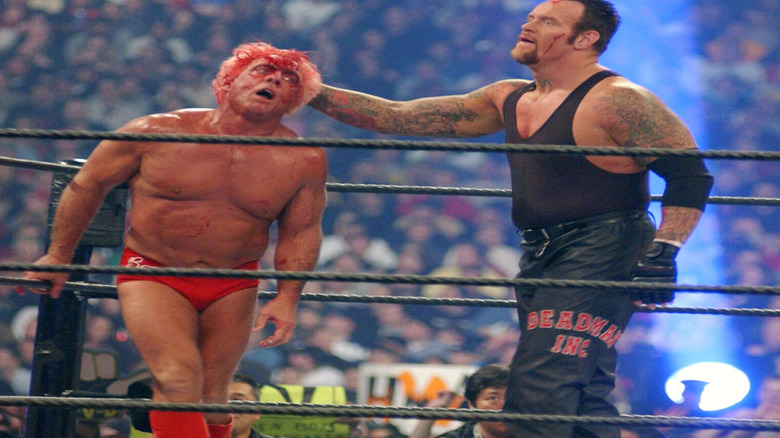What Blading Means In Pro Wrestling (And Who Has Banned It)
People unfamiliar with the industry often enjoy pointing out the fact that professional wrestling is "fake," but they may not be aware that there are many elements of the show that are more real than they might expect. When it comes to the use of blood in wrestling, while it is usually planned ahead of time, it's usually as real as can be. However, rather than being beaten to a pulp by their opponent, it's almost always the wrestler themselves who gets the blood moving, usually through a process called blading.
During the match, while working to make sure they aren't seen by the audience, the wrestler will grab a razor blade tucked away on their person or somewhere nearby and cut themselves with it, often on the forehead. That specific placement serves a few purposes. First, it results in an outpouring of blood across a wrestler's face, which then mixes with the wrestler's sweat to create a "crimson mask," as the industry calls it. This makes the blood clearly visible to the audience, both in the venue and (if the event is televised) those watching at home.
Additionally, the forehead cut ensures the wrestlers remain as safe as possible, as they won't be in danger of slicing open any primary veins. That's not to say that the cuts aren't deep, however — many older wrestlers, especially from bygone eras when blading was more common, bear intense scars at the top of their foreheads from the ritual, and some promotions today are trying to ban the practice entirely.
Banning the blade?
Like many aspects of pro wrestling history, the specifics of where and how blading originated are hard to pin down. However, it is known that wrestlers have been doing it for decades, dating back to when performers went to great effort to preserve the industry's secrets. Wrestlers like Ric Flair and Abdullah the Butcher both made frequent use of razor blades during their matches, and there are some promotions, such as ECW in the 1990s, that largely built their name off their reputation for violence. Blading is far less common these days, though there are still instances of it. AEW is one promotion that still uses the practice, with wrestlers like Jon Moxley known for their use of blood in matches.
Somewhere you likely won't often see wrestlers using razor blades is in WWE. The company banned the practice years ago, though there are exceptions to that rule when the situation calls for it. WWE enacted this policy in 2008, when its shows adopted a TV-PG rating and blood became far less frequent; wrestlers bleeding has become a more common occurrence since the departure of Vince McMahon, but it remains rare.
Beyond just WWE, TNA Wrestling has now followed in the footsteps of its business partner, enacting its own blading ban in May 2025. Like WWE, the company intends to allow some exceptions but reportedly hopes to cut down on the level of violence presented on their shows, as well as the dangers of blood-borne illnesses. It's difficult to watch any other promotion, however, without running the risk that a wrestler will "run the blade."

